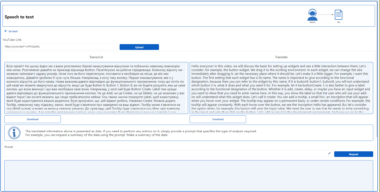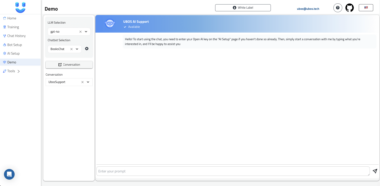UBOS Asset Marketplace: Unleashing the Power of MCP Servers for Intelligent Applications
In the rapidly evolving landscape of AI-driven development, the need for seamless integration between intelligent models and application ecosystems is paramount. The UBOS Asset Marketplace addresses this critical demand by offering a curated collection of MCP (Model Context Protocol) servers, designed to empower developers with the tools and services necessary to build smarter, more context-aware applications. Focusing specifically on MCP Servers for Cursor IDE, this marketplace provides a streamlined gateway to leveraging the power of AI within your development workflow.
Understanding MCP Servers: The Bridge Between Models and Context
Before delving into the specifics of the UBOS Asset Marketplace, it’s essential to grasp the core concept of MCP Servers. MCP, or Model Context Protocol, is an open protocol that standardizes how applications provide context to Large Language Models (LLMs). An MCP server acts as a crucial intermediary, enabling AI models to access and interact with external data sources, specialized tools, and real-time information. This capability is vital for applications that require more than just raw processing power; they need a deep understanding of the environment in which they operate.
Think of MCP servers as specialized data connectors and tool orchestrators for AI models. They provide the means for LLMs to move beyond generic knowledge and tap into specific domains, data repositories, and application functionalities. Without MCP servers, AI models remain isolated, unable to fully leverage the richness of external context.
The UBOS Advantage: A Full-Stack AI Agent Development Platform
UBOS is a full-stack AI Agent Development Platform designed to bring the power of AI Agents to every business department. The platform empowers you to:
- Orchestrate AI Agents: Manage and coordinate multiple AI Agents to work together on complex tasks.
- Connect with Enterprise Data: Seamlessly integrate AI Agents with your existing data sources.
- Build Custom AI Agents: Tailor AI Agents with your LLM model and Multi-Agent Systems.
The UBOS platform emphasizes ease of use, scalability, and security, making it accessible to both seasoned AI developers and those new to the field.
UBOS Asset Marketplace for MCP Servers: A Deep Dive
The UBOS Asset Marketplace for MCP Servers is a carefully curated repository of pre-built services that adhere to the MCP standard. These servers extend the capabilities of Cursor IDE, providing developers with intelligent features that streamline coding, enhance collaboration, and accelerate development cycles. The marketplace addresses the growing demand for modular, reusable AI components that can be easily integrated into existing workflows.
Key Features and Benefits:
- Discoverability: The marketplace offers a central location to discover and evaluate a wide range of MCP servers, saving developers valuable time and effort.
- Quality Assurance: Each MCP server listed on the marketplace undergoes a rigorous review process to ensure compatibility, security, and performance.
- Ease of Integration: The MCP standard simplifies the integration process, allowing developers to quickly deploy and utilize servers without complex configuration.
- Extensibility: The marketplace encourages contributions from the developer community, fostering a collaborative ecosystem of innovation.
- Version Control and Management: Ensures you have access to the latest stable versions of MCP Servers and facilitates easy rollback if needed.
- Cost-Effectiveness: By leveraging pre-built MCP servers, developers can reduce development costs and accelerate time-to-market.
Use Cases:
1. Intelligent Code Completion and Suggestion:
Imagine typing code within Cursor IDE and receiving real-time suggestions based on the current context, project dependencies, and best practices. MCP servers can analyze code patterns, identify potential errors, and suggest optimized solutions. This dramatically improves coding speed and reduces the likelihood of bugs.
- How it works: An MCP server analyzes the code being written in Cursor IDE. It uses this context, along with information from project dependencies and coding standards, to generate intelligent code completion suggestions. These suggestions appear directly within the IDE, allowing developers to quickly and easily insert the most appropriate code.
2. Automated Documentation Generation:
Creating comprehensive and up-to-date documentation is often a time-consuming task. MCP servers can automatically generate documentation from code comments, function signatures, and API specifications. This ensures that documentation remains synchronized with the codebase and reduces the burden on developers.
- How it works: The MCP server parses the code, extracts relevant information, and uses this information to generate documentation in a variety of formats (e.g., Markdown, HTML). The generated documentation can be automatically updated whenever the code changes, ensuring that it always reflects the current state of the project.
3. Real-Time Error Detection and Debugging:
Identifying and fixing errors early in the development process is crucial for maintaining code quality. MCP servers can analyze code in real-time, detecting potential errors, vulnerabilities, and performance bottlenecks. This allows developers to address issues proactively and prevent them from escalating into major problems.
- How it works: The MCP server analyzes the code as it is being written, looking for common errors, security vulnerabilities, and performance issues. When an issue is detected, the server provides an alert to the developer, along with suggestions for how to fix it.
4. Code Refactoring and Optimization:
As codebases grow, they often become complex and difficult to maintain. MCP servers can automatically refactor code, improving its structure, readability, and performance. This makes it easier for developers to understand and modify the code, reducing the risk of introducing new bugs.
- How it works: The MCP server analyzes the code and identifies opportunities for refactoring, such as removing duplicate code, simplifying complex logic, and improving naming conventions. The server then automatically applies these refactorings, ensuring that the code remains functional and efficient.
5. Collaborative Code Review and Feedback:
Code reviews are an essential part of the software development process, but they can often be time-consuming and inefficient. MCP servers can streamline the code review process by automatically identifying potential issues and providing feedback to developers. This allows reviewers to focus on the most important aspects of the code, reducing the time and effort required for code reviews.
- How it works: The MCP server analyzes the code being reviewed and identifies potential issues, such as style violations, security vulnerabilities, and performance bottlenecks. The server then provides feedback to the developer, highlighting these issues and suggesting ways to address them.
Examples of MCP Servers Available on the UBOS Asset Marketplace:
Based on provided MCP Server Info data following services can be implemented:
- Demo Service: Illustrates the fundamental structure and development approach of MCP services. Provides a simple request-response example with basic error handling and detailed code annotations, making it ideal for learning.
- Weather Service: Offers global weather query capabilities, including real-time weather updates and 5-day forecasts. Supports multi-city queries with detailed weather information.
Diving Deeper into the Weather Service Example
The MCP Server Info provides a solid foundation for understanding the weather service, let’s explore its capabilities in more detail with a possible UBOS integration.
- Real-time Data: The Weather Service could tap into various weather APIs (e.g., OpenWeatherMap - as suggested in the
MCP Server Info) to provide up-to-the-minute weather conditions for any location. - Predictive Capabilities: By analyzing historical weather data and applying machine learning algorithms, the service could provide more accurate and reliable forecasts.
- Alerts and Notifications: Users could set up personalized alerts to be notified of significant weather events, such as storms or extreme temperatures.
- Integration with Other Services: The Weather Service could be integrated with other applications, such as travel planning tools or smart home systems, to provide context-aware information and automate tasks.
A Concrete Scenario
Imagine a developer working on a travel application within Cursor IDE. They can seamlessly integrate the Weather Service MCP Server to provide users with real-time weather information for their destinations. The application could automatically suggest appropriate clothing, activities, and precautions based on the weather forecast. This level of integration enhances the user experience and provides valuable context.
Getting Started with the UBOS Asset Marketplace for MCP Servers
Integrating MCP Servers from the UBOS Asset Marketplace into your Cursor IDE workflow is a straightforward process:
- Explore the Marketplace: Browse the available MCP servers and identify the ones that meet your specific needs.
- Select and Install: Choose the desired MCP server and follow the installation instructions provided.
- Configure the Server: Configure the server with the necessary credentials and settings.
- Integrate with Cursor IDE: Integrate the server with your Cursor IDE environment by following the guidelines provided.
- Start Developing: Begin leveraging the power of the MCP server within your development workflow.
Leveraging the Provided Code Structure from MCP Server Info
The example project structure in MCP Server Info is excellent for those wanting to create and publish their own MCP servers on the UBOS marketplace. Key aspects to focus on:
- Three-Layer Architecture: Config, Controllers, Service. This separation of concerns is a best practice. Config handles constants and types, Controllers manage requests, and Service implements the core logic. This makes code more maintainable and testable.
index.tsImportance: Theindex.tsfile in each service is the entry point. It initializes the service, registers the MCP tools, and handles standard input/output. Ensuring this file is correctly configured is crucial.- Configuration via
mcp.json: The configuration in~/.cursor/mcp.jsonis how Cursor IDE discovers and interacts with the MCP servers. Proper setup here is vital for integration.
The Future of AI-Powered Development
The UBOS Asset Marketplace for MCP Servers represents a significant step forward in the evolution of AI-powered development. By providing a centralized repository of high-quality, reusable AI components, the marketplace empowers developers to build smarter, more context-aware applications with greater speed and efficiency. As the AI landscape continues to evolve, the UBOS Asset Marketplace will play a crucial role in shaping the future of software development.
The UBOS platform is committed to fostering a vibrant ecosystem of AI developers and innovators. The Asset Marketplace is just one component of this commitment. UBOS provides developers with the tools, resources, and support they need to build the next generation of intelligent applications.
Conclusion
The UBOS Asset Marketplace for MCP Servers unlocks a new era of possibilities for developers seeking to infuse their applications with AI-driven intelligence. By providing a curated collection of pre-built services, the marketplace simplifies the integration process, reduces development costs, and accelerates time-to-market. As the demand for AI-powered applications continues to grow, the UBOS Asset Marketplace will undoubtedly play a pivotal role in shaping the future of software development.
By embracing the power of MCP servers and leveraging the resources available on the UBOS Asset Marketplace, developers can unlock new levels of innovation and create applications that are truly intelligent, context-aware, and transformative. The future of AI-powered development is here, and the UBOS Asset Marketplace is your gateway to unlocking its full potential.
MCP Servers
Project Details
- fist-maestro/mcp-servers
- Last Updated: 3/31/2025
Recomended MCP Servers

TiDB MCP Server
Mallory - Cyber Threat Intelligence MCP Server
Browser MCP is a Model Context Provider (MCP) server that allows AI applications to control your browser
MCP Server allowing AI agents to control Google Chrome via the CodingBaby Extension

Generate images using gemini

read allure report(a type of test report )



RoCQ (Coq Reasoning Server)
 From vibe coding to vibe deployment. UBOS MCP turns ideas into infra with one message.
From vibe coding to vibe deployment. UBOS MCP turns ideas into infra with one message.





